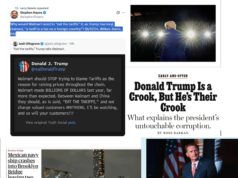 I’m cross posting this here from Scaling Green, as it’s directly relevant to Dominion Power, the Virginia State Corporation Commission (SCC), and all the ignorant, stupid s*** I’ve heard recently from the likes of Bill “ALEC” Howell about clean energy, the future of Dominion Power, etc, etc. Do these folks know anything at all about energy markets? Based on what they’ve been saying in recent days, it sure doesn’t seem that way. Now, here’s someone who actually DOES know what he’s talking about…David Roberts of Grist, who frankly is smarter than the entire SCC, Dominion Power executives and Virginia House of Delegates “leadership” put together. And no, that wasn’t meant as a backhanded compliment to David Roberts. 🙂
I’m cross posting this here from Scaling Green, as it’s directly relevant to Dominion Power, the Virginia State Corporation Commission (SCC), and all the ignorant, stupid s*** I’ve heard recently from the likes of Bill “ALEC” Howell about clean energy, the future of Dominion Power, etc, etc. Do these folks know anything at all about energy markets? Based on what they’ve been saying in recent days, it sure doesn’t seem that way. Now, here’s someone who actually DOES know what he’s talking about…David Roberts of Grist, who frankly is smarter than the entire SCC, Dominion Power executives and Virginia House of Delegates “leadership” put together. And no, that wasn’t meant as a backhanded compliment to David Roberts. 🙂
UPDATE 11:10 am Wednesday: It appears that even a hyper-conservative coal country legislator (State Sen. Bill Carrico) says he can live with the Clean Power Plan. No doubt because he knows, deep down, that it’s a winner for Virginia jobs and the economy. Meanwhile, the Bill Howells of the world are hard at work actually (albeit unintentionally/cluelessly) hastening the demise of Dominion Power.
The headline of this post is quite possibly the energy-related quote of the day, maybe the week or even month. It’s courtesy of David Roberts of Grist, back to providing us with consistently incisive analysis after a year-long sabbatical. Today, Roberts has a must-read post (in his case, maybe we should call it an “even-more-must-read-than-usual-for-David-Roberts” post) entitled, “Rooftop solar is just the beginning; utilities must innovate or go extinct.” It’s really worth your time to read the whole thing, and we strongly recommend you do that if you’re interested in the future evolution of clean energy (which of course you are if you’re reading this blog!). For now, here are the key points, including Roberts’ awesome quote.
- Distributed solar power poses a serious threat to power utilities, and “utilities are fighting back, attempting to impose additional fees and restrictions on solar customers.”
- The problem is, the way the utilities are fighting back – “cling[ing] to their familiar business model” while trying to recoup lost revenues through “rate-tweaking” – is not going to save them. Instead, they need to undertake “a wholesale rethinking of the utility business model” — “sooner” rather than later if they’re smart.
- Two new analyses — “Financial Impacts of Net-Metered PV on Utilities and Ratepayers” by Lawrence Berkeley National Laboratory (LBNL) and “Does Disruptive Competition Mean a Death Spiral for Electric Utilities?” by Elisabeth Graffy and Steven Kihm — zero in on the core problem(s) facing utilities faced with the “disruptive threat” of rapidly growing distributed solar power. For instance, what happens “if solar PV penetration rose to between 2.5 and 10 percent of total retail sales by 2022?” The answer: utilities equity and earnings fall a lot, while rates go up only a little. Which leads us right to Roberts’ superb quote: “Solar PV is mostly a threat to utility investors and shareholders, not ratepayers.”
- The problem for utilities is that their whole business model is based on building “more power plants and power lines,” which as Roberts points out is both “insane” (in that it’s not just diametrically opposed to “our social and environmental goals”), but also the polar opposite of where power markets are headed — towards more distributed power and more consumer autonomy.
- Does all this mean an inevitable “death spiral” for investor-owned utilities? Not necessarily, according to the Graffy and Kihm analysis, as long as utilities are willing and able to muster “the organizational foresight and habits needed to respond proactively to disruptive threats.” The problem, in Roberts’ view, is that after “a century of enjoying regulated-monopoly status, with returns guaranteed by law and expansion as far as the eye could see, utilities have virtually none of [that].”
- Another, short-term option for utilities is to try to recover their costs by raising rates, fees, etc. to consumers. The problem with this approach, of course, is that it only leads to “a bunch of dissatisfied customers seeking non-grid alternatives,” and “a growing market that will attract more and more entrepreneurial attention, thus accelerating customer defections.” In short, “The longer utilities try to hold back the wave with legal or regulatory roadblocks, the harder it will hit them when it finally comes.”
- The bottom line is that utilities need to adapt to the distributed solar power revolution, and fast. If they try to resist this revolution, their demise – the “death spiral” – will only be more assured (and probably more sudden). The alternative: “Instead of viewing ratepayers as passive sources of cost recovery, utilities ought to view them as, y’know, customers. Offer them products and services that satisfy their evolving preferences.” We’ll see if they’re smart enough to do that, but as Roberts points out, “regulated-monopoly” utilities are simply “not prepared for this sh*t.” In other words, the next few years will be crucial – not to mention fascinating to observe as this process plays out.



 Sign up for the Blue Virginia weekly newsletter
Sign up for the Blue Virginia weekly newsletter

![Friday News: “Ukraine accuses Russia of undermining peace talks with new demands”; “Trump’s Bromance With Arab Leaders”; “The Day Grok Told Everyone about [100% false] ‘White Genocide’”; Trump’s 2024 Senior Strategist Calls Earle-Sears’ Campaign “Amateurs”](https://bluevirginia.us/wp-content/uploads/2025/05/montage0516-238x178.jpg)





